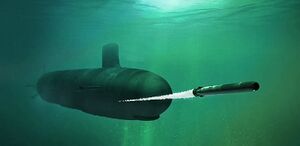Type-60 Attack Submarine
 Type-60 Bonnethead SSP
| |
| Class overview | |
|---|---|
| Name: | Type-60 |
| Builders: | Marivál Shipbuilding |
| Operators: |
|
| In commission: | 3rd January, 2009 |
| Completed: | 12 |
| Active: | 11 |
| Lost: | 0 |
| Retired: | 0 |
| General characteristics | |
| Type: | AIP Attack Submarine |
| Length: | 78.6 m (258 ft) |
| Beam: | 12.4 m (41 ft) |
| Draught: | 6.9 m (23 ft) |
| Propulsion: |
|
| Speed: | 20 knots (37 km/h) |
| Endurance: | 42 days |
| Sensors and processing systems: |
list error: <br /> list (help)
|
| Armament: |
list error: <br /> list (help) |
The Type-60 Attack Submarine is an air-independent propulsion submarine (SSP) in service with the Inyurstan Navy It has been dubbed the "Bonnethead" after a small species of shark which often hunts in shallow reefs between coral columns, similar to the nature of this submarine.
Design
Like most submarines, the Type-60 is built for minimalized sonar and acoustic signatures. Included in the design are anechoic tiles and a pump-jet propulsor to mask submarine noise when in motion. All on-board equipment is seated in ballistic rubber to reduce operating noise, while noise monitoring systems alert the crew to how much acoustic disruptions the vessel is causing. Dozens of built-in electromagnets to help offset the vessels electromagnetic signature while a similar monitoring device is used to keep track of the submarines magnetic anomaly. Weapons are launched via a water ram expulsion system to avoid acoustic detection when exiting the torpedo tubes.
Propulsion is provided by two pump-jet propulsors instead of traditional propellors. They are powered by two bio-ethanol engines, an electric motor and fueled by two AIP fuel cell units.
Sensors
The primary sonar system is the ESQ/SS-4 Passive/Active array mounted in the bow of the Type-60. This system is capable of detecting softball-sized targets in excess of 80km on active mode, and can intercept acoustic noise at almost twice that distance. Navayelle Systems provided it's Vesper High-Frequency sonar, giving the submarine class a near-360o coverage including the rear, sides, top and bottom of the submarine. Secondary coverage is provided by a fiber optic wide aperture array.
Unified Modular Masts (UMMs) provide all accessory sensory capabilities, including a low-intercept AESA radar, laser rangefinder, ESM equipment, SATCOM equipment, etc. Instead of a traditional periscope, this submarine utilizes a photonic mast for imaging surveillance.
Type-60 submarines are equipped with the APSKA (Active & Passive Soft-Kill Array) Counter-Measure Suite. This system includes:
- Towed Passive Array; idealized for detection of enemy torpedoes
- Acoustic Projector; to create false acoustic contacts
- Tube-launched Sonar Decoy
- Rear-launched Expendable Decoys (4x4); for close-range torpedo avoidance, each decoy emits a high degree of noise and cavitation
Armament
The primary armament of the Type-60 SSP are its four 533mm torpedo tubes; this submarine class was originally built and used with the Mk-48 ADCAP, but now primarily carry the Pu98 Arraiá torpedo.
A pair of mast-mounted Lusca-III infrared guided SAMs are also equipped in order to defend against helicopters and low-flying seaplanes. Mines, such as the Mk-60 CAPTOR, can also be carried by this submarine.